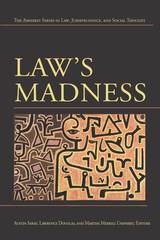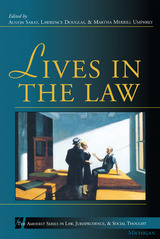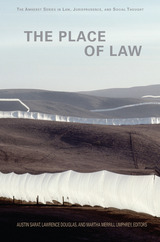3 books about Umphrey, Martha

Law's Madness
Austin Sarat, Lawrence Douglas, and Martha Merrill Umphrey, Editors
University of Michigan Press, 2006
Law and madness? Madness, it seems, exists outside the law and, in principle, society struggles to keep these slippery terms separate. From this perspective, madness appears to be law's foil, the chaos that escapes law's control and simultaneously justifies its existence. Law's Madness explores the gray area between the realms of reason and madness.
The distinguished contributors to Law's Madness propose a fascinating interdisciplinary approach to the instability and mutual permeability of law and madness. Their essays examine a variety of discursive forms—from the literary to the historical to the psychoanalytic—in which law is driven more by narrative than by reason. Their studies delineate the ways in which the law takes its definition in part from that which it excludes, suppresses, or excises from itself, illuminating the drive to enforce barriers between non-reason and legality, while simultaneously shedding new light on the constitutive force of the irrational in legal doctrine.
Law's Madness suggests that the tense and paradoxical relationship between law and madness is precisely what erects and sustains law. This provocative collection asks what must be forgotten in order to uphold the rule of law.
Austin Sarat is William Nelson Cromwell Professor of Jurisprudence and Political Science at Amherst College. Lawrence Douglas is Associate Professor of Law, Jurisprudence, and Social Thought at Amherst College. Martha Merrill Umphrey is Associate Professor of Law, Jurisprudence, and Social Thought at Amherst College.
The distinguished contributors to Law's Madness propose a fascinating interdisciplinary approach to the instability and mutual permeability of law and madness. Their essays examine a variety of discursive forms—from the literary to the historical to the psychoanalytic—in which law is driven more by narrative than by reason. Their studies delineate the ways in which the law takes its definition in part from that which it excludes, suppresses, or excises from itself, illuminating the drive to enforce barriers between non-reason and legality, while simultaneously shedding new light on the constitutive force of the irrational in legal doctrine.
Law's Madness suggests that the tense and paradoxical relationship between law and madness is precisely what erects and sustains law. This provocative collection asks what must be forgotten in order to uphold the rule of law.
Austin Sarat is William Nelson Cromwell Professor of Jurisprudence and Political Science at Amherst College. Lawrence Douglas is Associate Professor of Law, Jurisprudence, and Social Thought at Amherst College. Martha Merrill Umphrey is Associate Professor of Law, Jurisprudence, and Social Thought at Amherst College.
[more]

Lives in the Law
Austin Sarat, Lawrence Douglas, and Martha Merrill Umphrey, Editors
University of Michigan Press, 2002
The essays look at the consequences that legal practice has on the lives of its practitioners as well as on the individual legal subject and on the shape of shared identities. These essays challenge liberal and communitarian notions of what it means to live the law.
In the first of the essays, Pnina Lahav presents a study of the Chicago Seven Trial to paint a picture of the law's power to serve as a site for the definition of a collective group identity. In contrast, Sarah Gordon focuses on the experience of an individual legal subject, namely, the defendant in the Hester Vaughn trial, a notorious nineteenth-century case of infanticide. Frank Munger looks at how law constructs the identity of women and explores the strategies by which poor women resist the law's construction of their dependency. In the fourth essay, Vicki Schultz offers a moral vision of equality that straddles the liberal and communitarian positions with her articulation of the concept of a "life's work." Lastly, Annette Wieviorka examines the recent trial of Maurice Papon for complicity in crimes against humanity to reveal how the very identity of a nation--in this case, France--can be defined through juridical and legal acts.
Austin Sarat is William Nelson Cromell Professor of Jurisprudence and Political Science and Professor of Law, Jurisprudence and Social Thought, Amherst College. Lawrence Douglas is Associate Professor of Law, Jurisprudence and Social Thought, Amherst College. Martha Umphrey is Assistant Professor of Law, Jurisprudence and Social Thought, Amherst College.
[more]

The Place of Law
Austin Sarat, Lawrence Douglas, and Martha Merrill Umphrey, Editors
University of Michigan Press, 2003
It has long been standard practice in legal studies to identify the place of law within the social order. And yet, as The Place of Law suggests, the meaning of the concept of "the place of law" is not self-evident.
This book helps us see how the law defines territory and attempts to keep things in place; it shows how law can be, and is, used to create particular kinds of places -- differentiating, for example, individual property from public land. And it looks at place as a metaphor that organizes the way we see the world. This important new book urges us to ask about the usefulness of metaphors of place in the design of legal regulation.
[more]
READERS
Browse our collection.
PUBLISHERS
See BiblioVault's publisher services.
STUDENT SERVICES
Files for college accessibility offices.
UChicago Accessibility Resources
home | accessibility | search | about | contact us
BiblioVault ® 2001 - 2024
The University of Chicago Press









